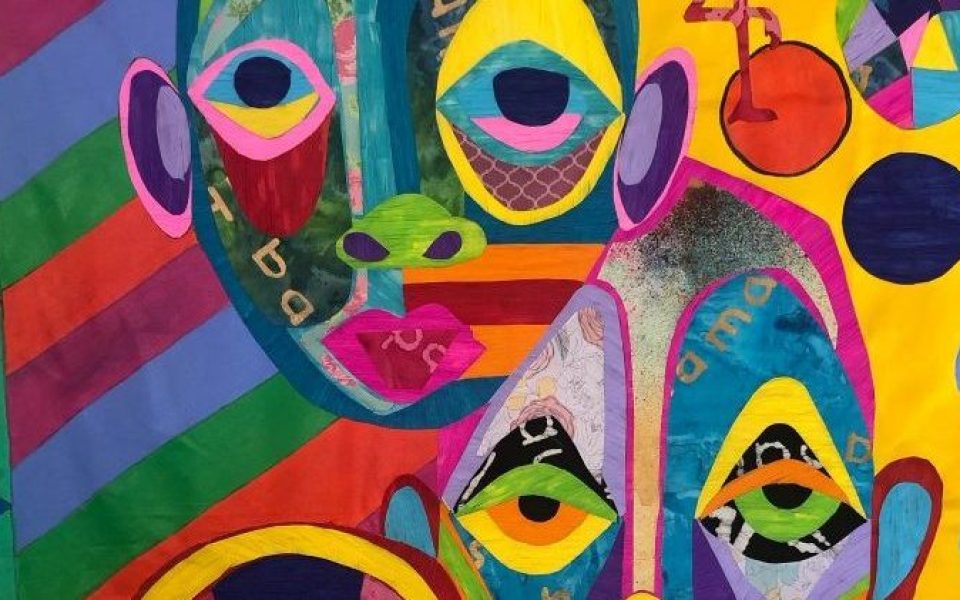Hunter
Levinsohn builds a campfire from newspaper in the middle of the Guilford
College Art Gallery.
She
folds each page of the New York Times
and metaphorically lights it ablaze with a piece of neon orange duct tape on
each end. Facing away from the paper flame sits a simple, gray lawn chair.
Inside the chair’s cupholder, an editorial hides away, rolled up.
“It
talks about, by doing nothing,” Levinsohn explains, “you are contributing to
the cruelty and inhumanity of this time.”
This
seat, Levinsohn says, is not somewhere the viewer should probably sit.
Levinsohn’s
piece, one among a dozen, fills the Guilford College Art Gallery in an exhibit
titled Twelve Places: Redux. The show,
which opened on Sept. 20, revamps a similar show of women’s art held in 1979 — 40
years ago — at the Art School in Carrboro.
The
original Twelve Places involved a
dozen female artists from Center/Gallery, an all-women’s group of artists who
worked out of the Triangle in the late ‘70s. The collective gathered as a
response to a lecture from Lucy Lippard — an author and art critic who focused
on feminist issues — during her visit to UNC’s campus in 1978. Like a piece
from the early ’70s by Judy Chicago, “The
Dinner Party,” which utilized tableware to discuss women’s history, Twelve Places featured each woman using
a chair and the wall nearby to represent herself.
Now,
the reworking of the original exhibit features many of the same women who
showcased their artwork, like Levinsohn, as well as other original members of
Center/Gallery along with women they have mentored over the year. While some
omit the chair idea, many seats still remain scattered throughout Guilford’s
art gallery.
In
this rendition, Koala Phoenix replaces her original antique oak chair with a transparent
one. A mannequin torso rests on the seat, a kaleidoscope of silk strands
reaching out from where its heart would be. Each fabric bit connects to a map
of the United States, long nails tacking them to important places in Phoenix’s
life. She mentions that connections remain important to her, and to her
identity as a woman. Redux, to her, embodies those connections, much
like its predecessor and the artistic movement it took influence from.
“It
was really the beginning of feminist art, or women in art making a claim to
being female and using that as a part of their subject matter,” she says.
Virginia
Tyler, a member of what she calls the “second wave” of Center/Gallery, also
sees art as a connector. Her metalworking piece, “Tribute to the God Tree III”,
combines a practice of creating papercasts of trees with her experience of
studying metalcasting in Ghana. The slabs of patterned bronze branch up to the
ceiling, modeled after a particular tree found in Kurofrofrom Village, Ghana, whose
bark can be used to make a fever-reducing tea.
“Art,
for me,” Tyler says, “is not a solitary experience.”
Tyler,
a mentor herself, finds the creative conversation extending, with the inclusion
of the newest generation in Twelve
Places: Redux. One of her students, Blair Gray, hangs her work up on the
front wall. Gray says art acts like an autobiography, illustrating each facet
of a person’s identity. Her work, “Junkanoo Rosa,” quilts together her life
experiences as a Bahamian woman through the lens of the annual Bahamian festival
holiday. Large shapes and bold outlines form patterns around the border of a
tapestry, with fringe hanging from the sides. The shapes collage together into
faces and flowers, which sprawl across a bold yellow backdrop.
“Junkanoo
Rosa” sits on the opposite wall as “Tribute to the God Tree III.” Gray says
displaying her work nearby the work of the woman who taught her means the show
will not end after the closing date.
“Being part of another generation shows that this can be continued,” Gray says. “There can be another 12 women who have the opportunity to do another show.”
Twelve Spaces Redux runs until Dec. 15 and is displayed at the Guilford College Art Gallery. For more info, visit the website here.
Join the First Amendment Society, a membership that goes directly to funding TCB‘s newsroom.
We believe that reporting can save the world.
The TCB First Amendment Society recognizes the vital role of a free, unfettered press with a bundling of local experiences designed to build community, and unique engagements with our newsroom that will help you understand, and shape, local journalism’s critical role in uplifting the people in our cities.
All revenue goes directly into the newsroom as reporters’ salaries and freelance commissions.


Leave a Reply